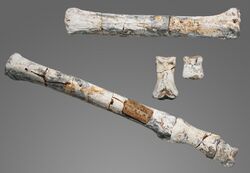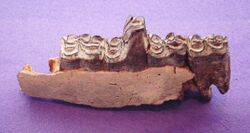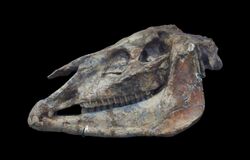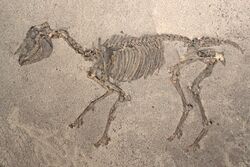Biology:Hippotherium
From HandWiki
Short description: Extinct genus of mammals
| Hippotherium | |
|---|---|
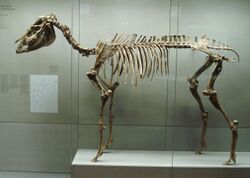
| |
| Skeleton of Hippotherium primigenium, Staatliches Museum für Naturkunde Stuttgart | |
| Scientific classification | |
| Domain: | Eukaryota |
| Kingdom: | Animalia |
| Phylum: | Chordata |
| Class: | Mammalia |
| Order: | Perissodactyla |
| Family: | Equidae |
| Subfamily: | Equinae |
| Tribe: | †Hipparionini |
| Genus: | †Hippotherium Kaup, 1832 |
| Species | |
| |
Hippotherium is an extinct genus of horse that lived in during the Miocene through Pliocene ~13.65—6.7 Mya, existing for 6.95 million years.
The last known surviving Hippotherium was H. malpassii, found in Italy.[1]
Species
The type species, H. primigenius, is known from Miocene deposits in Europe and the Middle East, while the species H. koenigswaldi and H. catalaunicum have been found in Miocene deposits in Spain.[citation needed] The Asian hipparionin "Hipparion" weihoense from early Late Miocene deposits in northern China has also been referred to the genus.[2]
Fossil distribution
- Doue-la-Fontaine France estimated age: ~13.65—7.25 Mya.
- Lower Bakhtiari Formation, northern Iraq, estimated age: ~11.6—9.0 Mya.
- Kurtchuk-Tchekmedje, Turkey estimated age: ~11.61—5.33 Mya.
References
- ↑ Bernor, Raymond L.; Kaya, Ferhat; Kaakinen, Anu; Saarinen, Juha; Fortelius, Mikael (2021). "Old world hipparion evolution, biogeography, climatology and ecology". Earth-Science Reviews 221. doi:10.1016/j.earscirev.2021.103784. Bibcode: 2021ESRv..22103784B. https://www.sciencedirect.com/science/article/pii/S0012825221002853.
- ↑ Raymond L. Bernor; Shiqi Wang; Yan Liu; Yu Chen; Boyang Sun (2018). "Shanxihippus dermatorhinus comb. nov. with comparisons to old world hipparions with specialized nasal apparati". Rivista Italiana di Paleontologia e Stratigrafia. 124 (2): 361–386. doi:10.13130/2039-4942/10202.
Wikidata ☰ Q3785745 entry
 |

